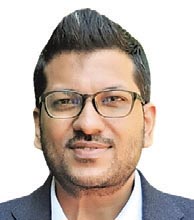Columns
A summer of discontent
Nepal’s unrest is not an isolated episode. It is part of a wider Asian tableau.
Siddharth Poddar
Early September’s deadly protests that saw the resignation of Prime Minister KP Oli and the dissolution of the parliament were about accountability. Kathmandu’s streets saw the roll out of anger and a palpable sense of frustration. The government fell in less than two days, but claimed scores of lives on the way out.
Betrayed by corruption, a lack of economic opportunity and inequality, many were disillusioned by a political class that seemed indifferent. Exacerbating issues was the sheer impunity with which political leaders conducted their business.
Nepal’s unrest, however, is not an isolated episode. It is part of a wider Asian tableau—a summer of discontent stretching from Ulaanbaatar to Jakarta and Manila. These incidents followed protests in Bangladesh in 2024 and Sri Lanka in 2022.
These eruptions, while stemming from local grievances related to corruption, government negligence and inequality, also seem to mark something bigger: A shift in how young citizens across Asia view their elected leaders and their refusal to accept the status quo. For decades, the response to corruption, inefficiency and government excess was often a resigned shrug, a fatalistic ke garne, which was commonly heard across Nepal.
Have times changed?
A recent survey conducted by the Pew Research Centre is instructive. It finds that in 20 out of the 25 countries surveyed, a vast majority of people say their political system either needs major change or complete reform. Dissatisfaction and frustration with political leaders is the key reason driving this sentiment.
Across the countries surveyed, there’s a strong belief that elected officials are not up to the mark. The median share that believes either most or all their elected officials are honest is only 14 percent. Separately, just one in six people surveyed believes that most elected leaders understand the needs of ordinary people or that they are ethical. And sadly, a similarly small share believes that their leaders are well-qualified or focused on their countries’ most important problems.
What this illustrates is that elected leaders are failing to even meet the minimum standards expected (or required) of anyone in positions of authority.
It would be fair to say this has fostered a sense of frustration and disillusionment. The findings also suggest that economic growth alone may not inoculate governments against public anger. However, its absence, coupled with a similar absence of opportunities for the youth, simply magnifies the anger. As country after country showed, we’re over the tipping point.
A regional phenomenon
Nepal’s upheaval is just one strand in a regional pattern. While the triggers for the mass protests across Asian countries have been different, they’ve been underscored by a common denominator: Anger at corruption, perceived government excess and the lack of accountability among the political elite.
Street protests in Indonesia have stemmed from a cost-of-living crisis and plans to increase ministerial allowances and expenses. In the Philippines, thousands took to the streets following allegations that the country lost billions of dollars to corruption-ridden flood relief projects that never materialised. In Mongolia, the government has felt the ire of youth frustrated with corruption. In Bangladesh, protests over a job quota system quickly transformed into an anti-government movement fighting against shrinking democratic space in the country.
The recent Pew Research survey found that in Bangladesh, Indonesia and the Philippines, more than two-thirds of respondents wanted sweeping reform, not surprising given the sentiment against the leaders in these countries.
But scepticism runs deep. Across most countries surveyed, fewer than half the respondents believe change will actually happen.
This combination of yearning mixed with fatalism captured the mood in Nepal too, where citizens have sought reform but have seen leaders attempt to subvert it time and time again. Nepal has a young population—as do a few of the other Asian countries—that is more digitally connected than any before it. The proliferation of social media apps has led to the rapid spread of information and the fermenting of dissent, and eventually mobilisation, as we saw in Nepal earlier this month. Hashtags galvanised crowds and ignited outrage and resulted in a pace of mobilisation scarcely experienced before.
Nepal is no stranger to protests, be it in 1990 or 2006, but this time was different. These protests both in Nepal, as well as in other parts of Asia, have demonstrated how fast information can travel, and how quickly public dissent can take a form hard to manage.
Where to, now?
That’s a question many have asked, and the answer will only be clear in the months and years to come. In Nepal, there’s optimism at the moment that there will be real change come March, but for that to happen, the after-effects of the protests must also manifest in something that is politically tangible. For now, that means seats in parliament for a new party—or new faces—that better reflect the mood of the country, and the aspirations of its youth.
More broadly, Nepal’s September protests, though rooted in local grievances, hint at something larger—a regional mindset shift, away from apathy and resignation.




 10.12°C Kathmandu
10.12°C Kathmandu













%20(1).jpg&w=300&height=200)

